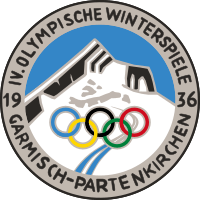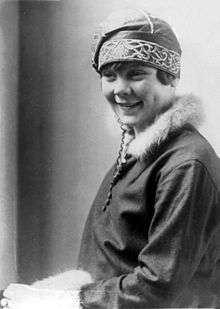1936 Winter Olympics
 Logo of the 1936 Winter Olympics[lower-alpha 1] | |||
| Host city | Garmisch-Partenkirchen, Germany | ||
|---|---|---|---|
| Nations | 28 | ||
| Athletes | 646 (566 men, 80 women) | ||
| Events | 17 in 4 sports (8 disciplines) | ||
| Opening | 6 February | ||
| Closing | 16 February | ||
| Opened by | Führer Adolf Hitler | ||
| Stadium | Große Olympiaschanze | ||
| Winter | |||
| |||
| Summer | |||
| |||
The 1936 Winter Olympics, officially known as the IV Olympic Winter Games (French: Les IVes Jeux olympiques d'hiver) (German: Olympische Winterspiele 1936), were a winter multi-sport event which was celebrated in 1936 in the market town of Garmisch-Partenkirchen in Bavaria, Germany. Germany also hosted that year's Summer Olympics in Berlin. 1936 is the last year in which the Summer and Winter Games were both held in the same country (the cancelled 1940 Games would have been held in Japan, with that country likewise hosting the Winter and Summer games).
The 1936 Winter Olympics were organized on behalf of the German League of the Reich for Physical Exercise (DRL) by Karl Ritter von Halt. Von Halt had been named President of the Committee for the organization of the Fourth Winter Olympics in Garmisch-Partenkirchen by Reichssportführer Hans von Tschammer und Osten.
Highlights

- German skier Willy Bogner took the Olympic oath during the opening ceremonies.
- Alpine skiing made its first appearance in the winter Olympics as the combined, which added a skier's results in both the downhill and slalom. German athletes Franz Pfnür won men's alpine and Christl Cranz won women's alpine events.
- Ivar Ballangrud won three out of the four speed skating races.
- Sonja Henie won her third consecutive gold medal in woman's figure skating.
- Switzerland won the 4 man bobsled in a time of 5:19.85.
- Great Britain upset 1932 gold medalists Canada in ice hockey when Edgar Brenchley scored the winning goal within the last ninety seconds.
- The country who won the overall games was Norway with a total of 7 gold medals, 5 silver medals and 3 bronze medals.
- These games had the largest and heaviest medals ever awarded to athletes: 100 mm diameter, 4 mm thick, weighing 324 g.
Sports
Medals were awarded in 17 events contested in 4 sports (8 disciplines).


- Skating


- Skiing





Demonstration sports
Venues
- Große Olympiaschanze – Cross-country skiing, Nordic combined, Opening and Closing Ceremonies, and Ski Jumping.
- Gudiberg – Alpine skiing (combined – slalom)
- Kreuzjoch – Alpine skiing (combined – downhill)
- Kreuzeck – Alpine skiing (downhill finish line)
- Olympia-Kunsteisstadion – Figure skating and Ice hockey
- Riessersee and surrounding areas – Bobsleigh, Ice hockey, and Speed skating
Participating nations
28 nations sent athletes to compete in Germany. Australia, Bulgaria, Greece, Liechtenstein, Spain, and Turkey all made their Winter Olympic debut in Garmisch-Partenkirchen, and Estonia, Latvia, Luxembourg, the Netherlands, and Yugoslavia all returned to the Games after having missed the 1932 Winter Olympics.
| Participating National Olympic Committees |
|---|
|
Medal count
* Host nation (Germany)
| Rank | Nation | Gold | Silver | Bronze | Total |
|---|---|---|---|---|---|
| 1 | 7 | 5 | 3 | 15 | |
| 2 | 3 | 3 | 0 | 6 | |
| 3 | 2 | 2 | 3 | 7 | |
| 4 | 1 | 2 | 3 | 6 | |
| 5 | 1 | 2 | 0 | 3 | |
| 6 | 1 | 1 | 2 | 4 | |
| 7 | 1 | 1 | 1 | 3 | |
| 8 | 1 | 0 | 3 | 4 | |
| 9 | 0 | 1 | 0 | 1 | |
| 10 | 0 | 0 | 1 | 1 | |
| 0 | 0 | 1 | 1 | ||
| Totals (11 nations) | 17 | 17 | 17 | 51 | |
See also
References
Notes
- ↑ The 1936 Olympic Logo comprises the Olympic rings in the foreground and the summit of the Garmisch-Partenkirchen Alps with a ski track leading to the mountains in the background. Around, there is the inscription "IV. OLYMPISCHE WINTERSPIELE 1936
GARMISCH-PARTENKIRCHEN"
Citations
External links
| Wikimedia Commons has media related to 1936 Winter Olympics. |
- "Garmisch-Partenkirchen 1936". Olympic.org. International Olympic Committee.
- "Results and Medalists — 1936 Winter Olympics". Olympic.org. International Olympic Committee.
- Complete official IOC report. In German
- The program of the 1936 Garmisch-Partenkirchen Winter Olympics
Further reading
- Berlin Games – How Hitler Stole the Olympic Dream, by Guy Walters ISBN 0-7195-6783-1 (UK) 0060874120 (USA)
| Preceded by Lake Placid |
Winter Olympics Garmisch-Partenkirchen IV Olympic Winter Games (1936) |
Succeeded by Sapporo cancelled due to World War II |
